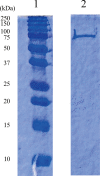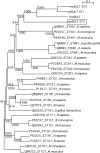Novel silkworm (Bombyx mori) sulfotransferase swSULT ST3 is involved in metabolism of polyphenols from mulberry leaves
- PMID: 35925958
- PMCID: PMC9352109
- DOI: 10.1371/journal.pone.0270804
Novel silkworm (Bombyx mori) sulfotransferase swSULT ST3 is involved in metabolism of polyphenols from mulberry leaves
Abstract
Polyphenols in plants are important for defense responses against microorganisms, insect herbivory, and control of feeding. Owing to their antioxidant, anti-cancer, and anti-inflammatory activities, their importance in human nutrition has been acknowledged. However, metabolism of polyphenols derived from mulberry leaves in silkworms (Bombyx mori) remains unclear. Sulfotransferases (SULT) are involved in the metabolism of xenobiotics and endogenous compounds. The purpose of this study is to investigate the metabolic mechanism of polyphenols mediated by B. mori SULT. Here, we identified a novel SULT in silkworms (herein, swSULT ST3). Recombinant swSULT ST3 overexpressed in Escherichia coli effectively sulfated polyphenols present in mulberry leaves. swSULT ST3 showed high specific activity toward genistein among the polyphenols. Genistein-7-sulfate was produced by the activity of swSULT ST3. Higher expression of swSULT ST3 mRNA was observed in the midgut and fat body than in the hemocytes, testis, ovary, and silk gland. Polyphenols inhibited the aldo-keto reductase detoxification of reactive aldehydes from mulberry leaves, and the most noticeable inhibition was observed with genistein. Our results suggest that swSULT ST3 plays a role in the detoxification of polyphenols, including genistein, and contributes to the effects of aldo-keto reductase in the midgut of silkworms. This study provides new insight into the functions of SULTs and the molecular mechanism responsible for host plant selection in lepidopteran insects.
Conflict of interest statement
The authors have declared that no competing interests exist.
Figures






Similar articles
-
Functional analysis of novel sulfotransferases in the silkworm Bombyx mori.Arch Insect Biochem Physiol. 2020 Jul;104(3):e21671. doi: 10.1002/arch.21671. Epub 2020 Mar 29. Arch Insect Biochem Physiol. 2020. PMID: 32227386
-
Novel aldo-keto reductase AKR2E9 regulates aldehyde content in the midgut and antennae of the silkworm (Bombyx mori).Arch Insect Biochem Physiol. 2023 Jan;112(1):e21979. doi: 10.1002/arch.21979. Epub 2022 Oct 25. Arch Insect Biochem Physiol. 2023. PMID: 36283966
-
Bombyx mori-derived aldo-keto reductase AKR2E8 detoxifies aldehydes present in mulberry leaves.Chem Biol Interact. 2022 Jan 5;351:109717. doi: 10.1016/j.cbi.2021.109717. Epub 2021 Oct 28. Chem Biol Interact. 2022. PMID: 34737151
-
Characterization of glutathione-specific gamma glutamyl cyclotransferase (ChaC) in Bombyx mori.Arch Insect Biochem Physiol. 2023 Sep;114(1):e22027. doi: 10.1002/arch.22027. Epub 2023 Jun 7. Arch Insect Biochem Physiol. 2023. PMID: 37283485 Review.
-
The progress and future of enhancing antiviral capacity by transgenic technology in the silkworm Bombyx mori.Insect Biochem Mol Biol. 2014 May;48:1-7. doi: 10.1016/j.ibmb.2014.02.003. Epub 2014 Feb 20. Insect Biochem Mol Biol. 2014. PMID: 24561307 Review.
Cited by
-
Call for biotechnological approach to degrade plastic in the era of COVID-19 pandemic.Saudi J Biol Sci. 2023 Mar;30(3):103583. doi: 10.1016/j.sjbs.2023.103583. Epub 2023 Feb 2. Saudi J Biol Sci. 2023. PMID: 36748033 Free PMC article. Review.
References
Publication types
MeSH terms
Substances
LinkOut - more resources
Full Text Sources

